Sandinista revolution: thirty-five years ago in Nicaragua overthrew the pro-American regime
[bCountry between oceans] [/ b]
Nicaragua is a small country. By the year 2013 its population exceeded only a few million people for 6, and the territory located between two world oceans - the Pacific and the Atlantic (Caribbean Sea) is also small - 129 494 square kilometers - provides the country with a far 95 in the area among the countries of the world. The population of Nicaragua is, first of all, Indians and descendants of mixed Indian-Spanish marriages - mestizos.
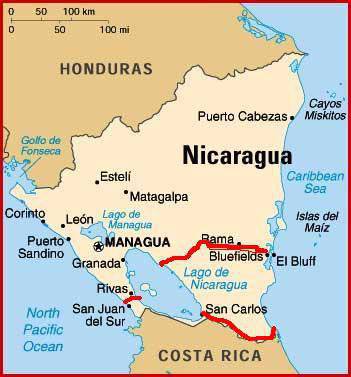
Despite its small size, Nicaragua has an interesting and full of momentous events. history. In many ways, the history of this small state is one big war for national liberation, interspersed by decades of dictatorial regimes with all their inherent drawbacks - political reaction, corruption, banditry, poverty of the overwhelming majority of the population and the economic enslavement of the country by foreign, primarily American, corporations .
The Nicaraguan coast was discovered by Christopher Columbus in 1502, but his colonization by the Spanish conquistadors began only twenty years later. In 1523, the lands of the future Nicaragua were incorporated into the Spanish possessions in America as audiencia Santo Domingo, later (in the 1539 year) they were subordinated to Panama, and then to the captaincy general of Guatemala.
It should be noted that unlike many other Spanish colonies in Latin America, the fate of Nicaragua did not turn out well. Here lived a significant Indian population, which was not at all enthusiastic about the actions of the colonialists and constantly raised anti-colonial uprisings. Secondly, the colonial governors themselves, using the low importance of Nicaragua for the Spanish crown and the associated inattention to the colony, periodically tried to secede from the metropolis.
Ultimately, in the 1821 year, almost 300 years after the colonization of Spain, Nicaragua declared independence from the Spanish crown - initially becoming part of the Mexican Empire, and then designated as part of the United Provinces of Central America. This state existed from 1823 to 1840. and included the territory of current Guatemala, Honduras, Nicaragua, El Salvador, Costa Rica, as well as the disappeared state of Los Altos (included part of the territory of modern Guatemala and the Mexican state of Chiapas). However, Spain officially recognized Nicaragua as an independent state only in 1850 year.
Throughout the nearly two hundred year history of its sovereignty, Nicaragua repeatedly became the object of aggression by the United States of America. As a matter of fact, the United States did not intend to annex the territory of a Central American state with a backward economy and impoverished Indian population, but on the other hand, it was happy to exploit the natural resources of Nicaragua. So, in 1856-1857. The country was ruled by American adventurer William Walker, who, with a detachment of mercenaries, captured Nicaragua and established a regime there that supported the southern slave states of the United States. Subsequently, Walker was shot in Honduras for his activities against the Central American states, but, following the adventurer, much more dangerous forces came to Central America.
From 1912 to 1933 for more than twenty years, the territory of Nicaragua was under the occupying power of the United States of America. By entering their troops into the territory of a sovereign state, the American leadership pursued as the main goal of the occupation to hinder the construction plans of the Nicaraguan channel by any other states except the USA. American marines were introduced into Nicaragua, whose units remained here until the 1933 year, causing outrage of the patriotic part of the population.
Sandino - Peasant General
The 1979 Nicaraguan revolution of the year is often called the Sandinista, although Augusto Sandino himself was no longer alive at the time. Sandino for Nicaragua is like Bolivar for Venezuela or Bolivia, like José Martí for Cuba. National hero, whose name has long become a national symbol. Augusto Cesar Sandino came from a peasant family, mestizo, and in his youth he spent five years in emigration in neighboring Honduras, Guatemala and Mexico, hiding from police prosecution for attempting to kill a man who had offended his mother. Most likely, it was during his residence in Mexico that Sandino became acquainted with revolutionary ideas and imbued with their liberation potential.
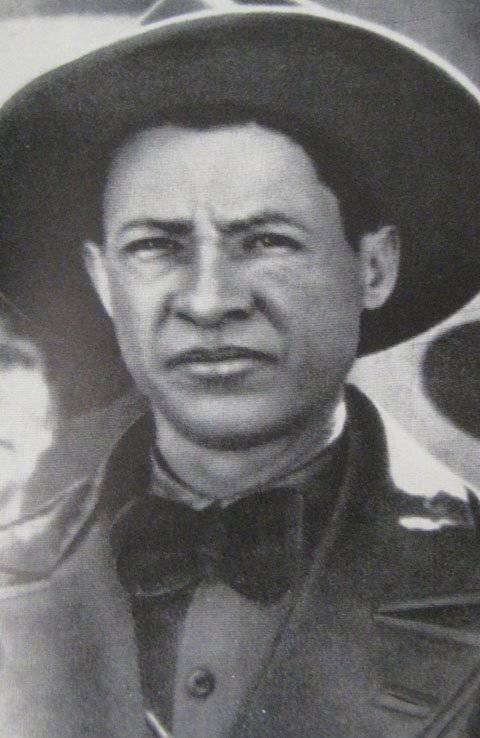
After the termination of the statute of limitation of responsibility for the crime he committed, he returned to Nicaragua, worked at the mine, and there he became interested in the political situation in his home country. By this time, Nicaragua was already 13 years under American occupation. Many patriots of Nicaragua did not like the current situation, especially since the pro-American regime directly impeded the economic development of the country and doomed its people to poverty. Sandino, a young and active man, all the more interested in emigration with revolutionary ideas, gradually began to gather around him supporters who also shared his indignation about American sovereignty in his native land.
Augusto Sandino was thirty-one years old when, in 1926, he rebelled against the pro-American government of Nicaragua. Having led a partisan detachment, Sandino set about guerrilla warfare — a guerrilla war against government forces and American occupiers. Many peasants, intellectuals, and even representatives of the well-to-do segments of the population, dissatisfied with American domination in the political and economic life of the country, began to join the ranks of the Sandinista movement. The Sandino detachment, numbering several hundred people, inflicted several defeats on glorified US marines.
It should be recalled that by this time the Expeditionary Corps of US Marine Corps, numbering 12 thousand people, was stationed in Nicaragua, besides at least eight thousand people had armed forces loyal to the pro-American regime. However, despite its large number, the pro-American government has not been able to cope with the peasant detachments of Augusto Sandino for several years. The uniqueness of the commanding talent and organizational skills of a young peasant who did not have any military education and even military service experience as an ordinary soldier was emphasized by many of his contemporaries and researchers of the history of the Sandinista movement of the following years.
Sandino's insurgent army was staffed, in the bulk, by volunteer peasants, but among its commanders there were many “internationalist revolutionaries” who arrived at Augusto headquarters from all over Latin America. This partisan Sandino war reminded Cuban guerrilla, also attracted numerous volunteers from all Latin American states. Thus, in the rebel army of Sandino, Salvadoran revolutionary Farabundo Martí, future leader of the Venezuelan Communists Gustavo Machado, Dominican Gregorio Hilbert, famed for organizing resistance to the landing of American marines in their homeland, fought.
To increase the effectiveness of the Nicaraguan army in the fight against the rebels, the American military command decided to transform the traditional armed forces of the country into the National Guard. The training of officers and soldiers of the National Guard was also carried out by American instructors. However, throughout the 1927-1932 biennium. Sandino's rebels succeeded in fighting successfully against the National Guard, and by 1932, half of the country was under the control of the rebels. In addition to the pro-American government and the contingent of US marines, Sandino also declared war on American industrial companies that exploited Nicaragua. First of all, it was about such monsters as the United Fruit Company, specializing in the monopolization of agricultural land in the countries of Central America. During one of the operations, the Sandino rebels captured and executed 17 American managers of the United Fruit Company.
The American leadership announced for the head of Augusto Sandino an award of 100 thousand dollars. However, the beginning of the economic crisis in the United States and the growing partisan movement in Nicaragua itself forced the Americans 2 in January 1933 of the year to withdraw their military units from the territory of Nicaragua. Moreover, mass anti-war demonstrations began in the States themselves, and many congressmen wondered about the eligibility of using US forces to fight outside the country without the proper permission of the legislature. Thus, in fact, Sandino became the liberator of the country from the American occupation. And the more tragic and unfair is his end - he was captured and shot by the head of the National Guard, Anastasio Somoza, who became the sole ruler of Nicaragua for many years.
"Three Fat Men" in Nicaragua
The regime of the clan Somoza can be called one of the most odious dictatorial boards in the history of mankind. However, unlike Hitler or Mussolini, the “three fat men” Somoza, who alternately replaced each other in power in Nicaragua, were not even capable of creating a strong state. Their credo began and ended with the theft of any state funds, the monopolization of all spheres of economic activity capable of generating any income, as well as demonstrative overconsumption of luxury goods.
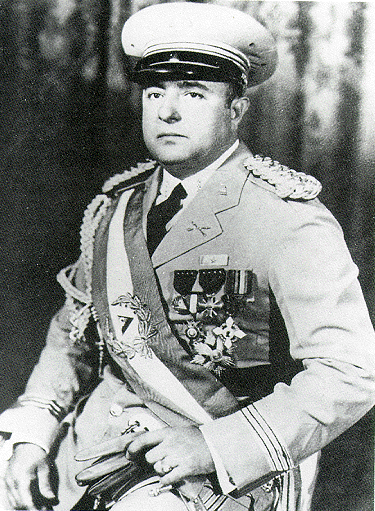
Anastasio Somoosa Sr. openly sympathized with the regime of Adolf Hitler, and tried to do this even when the “masters” of Somoza - the United States of America - entered World War II against Hitler's Germany. The Americans, however, had no choice but to put up with the antics of their “puppet”, because the latter was of interest to them, allowing them to plunder the national wealth of Nicaragua, to use the country’s territory unhindered in the interests of the United States, and besides, they hated communism and Soviet Union, in which the United States of those years saw for themselves the main danger.
In 1956, Anastasio Somoza was mortally wounded by the poet Rigoberto Lopez Perez, a member of a youth circle that set himself the goal of ridding Nicaragua of a dictator. Despite the efforts of American doctors, Somoza died, but the dictatorial regime he created continued to exist. "By inheritance" the power in the country passed to the eldest son of Anastasio Somoza, Luis Somose Debaile. The latter was not much different from his father, being no less a sadist and a corrupt official.
The reign in Nicaragua of the Clan Somoza continued for 45 years. During this time, Anastasio Somoza García, his eldest son Luis Somosa Debile, and the youngest son Anastasio Somoza Debaiile, replaced each other. During the years of the clan Somoza Nicaragua remained a puppet state in relation to the United States of America. Any political opposition in the country was suppressed, the regime carried out especially strong repression against the Communists.
When revolution triumphed in Cuba and revolutionaries led by Fidel Castro came to power, training camps were set up in Nicaragua to train Cuban "contras", which they were supposed to use in the struggle against the Castro government. All Somoses were terribly afraid of the communist threat, and therefore, in the victory of the Cuban revolution, they saw the danger, first of all, for their political positions in Nicaragua, knowing full well that such an event could not but cause ferment throughout Latin America.
The socio-economic situation in Nicaragua, which developed during the years of the clan Somoza, was impressive. A significant part of the country's population remained illiterate, there was a very high infant mortality rate, and all sorts of infectious diseases were widespread. Almost every fifth Nicaraguan suffered from tuberculosis. Naturally, the overall standard of living of the population was extremely low. One of the main products exported by Nicaragua in these decades has been plasma. Nicaraguans were forced to sell blood, because the Somoza regime did not provide them with any other income.
Numerous humanitarian aid sent by international organizations and even the United States to Nicaragua was practically openly plundered by the Somoz clan and its trusted people from the leadership of the National Guard and the police. The only thing, apart from its own enrichment, to which Somoz paid attention, was the strengthening of the force potential of the National Guard and other militias, through which the clan was going to protect itself from possible popular unrest. The power structures of Somoza functioned with the direct support of American intelligence services, their officers were trained in American training centers.
It is significant that even the Catholic clergy in general, negatively perceived the dictatorship of Somoza. Many of them actively participated in the opposition movement. By the way, Nicaragua became one of the centers of distribution of the so-called. "Liberation theology" - directions in Catholic theology, advocating the union of Christian values with the ideology of the struggle for social justice. In response to the activities of the revolutionary-minded priests, the Somoza regime intensified political repression, including against church representatives, but the latter only angered the peasant masses of the Nicaraguan population, for whom the authority of the priest always meant a lot. Naturally, the persecution of the priests by the National Guards inevitably entailed acts of revenge from the peasants, pushing the latter into the ranks of the rebel groups.
Sandinista revolution and the collapse of the dictatorship
At the same time, the ideological heirs of Augusto Sandino, who hated American imperialism and his puppets of the Somoz clan, fought against the guerrilla war for a long time. In 1961, the Nicaraguan patriots in exile in Honduras created the Sandinista National Liberation Front (FSLN), which played a key role in liberating the country from the pro-American regime. The Sandinists included supporters of various areas of socialist and communist thought, from pro-Soviet communists to supporters of the ideas of Ernesto Che Guevara and Mao Zedong. The training of the founders of the FSLN was carried out by Cuban revolutionaries, who considered it their duty to provide ideological, organizational and financial support to all the revolutionary socialist movements in Latin America, regardless of specific ideological differences.
The leader of the NFNC, Carlos Amador Fonseca, was repeatedly placed in prisons - not only in Nicaragua, but also in Costa Rica. He created his first revolutionary circle in 1956, uniting the then few young followers of Marxism (during the reign of Somos, the works of K. Marx, F. Engels and other representatives of Marxism and more widely - any socialist thought, were forbidden in Nicaragua).
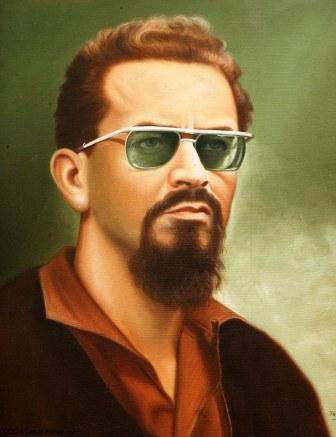
The intellectual Fonseca not only wrote books, setting out his own political views, but also personally participated in the hostilities. He is arrested many times - in 1956, 1957, 1959, 1964. And each time after the liberation, Fonseca returns to his daily activities - the organization of the anti-American underground in Nicaragua.
In August, Fonseca 1969 and his friend Daniel Ortega, who is currently the current president of Nicaragua, were once again released from prison after the FSLN took US citizens hostage and demanded to exchange political prisoners for them. After visiting Cuba, Fonseca returned to Nicaragua to lead the guerrilla movement, but was captured by the National Guard and 7 in November 1976 was brutally murdered. The severed arms and head of Carlos Fonseca were delivered personally to the dictator Anastasio Somoza.
However, the pro-American sadistic general could not long revel in his own power and impunity. Less than three years after the brutal assassination of Fonseca, the Sandinista National Liberation Front launched an offensive against the positions of the regime throughout the country. First of all, the rebels organize attacks on the barracks and command posts of the National Guard throughout Nicaragua. At the same time, partisan detachments attack the land of the Somoza family, which provokes support from the peasants in a hurry to seize land for use. Sandinista destroy the chief of staff of the National Guard Peres, commit attacks on many other prominent officers of the National Guard and political figures of the regime. In the cities of Nicaragua, numerous uprisings of the urban base break out, which capture entire neighborhoods over which the police lose control. At the same time, the Sandino radio station is launched, broadcasting into Nicaragua. Thus, the Somoza regime loses monopoly in the information space of the country.
Even the introduction of martial law in Nicaragua could not save Somoza. 17 July 1979, the dictator with the whole family, stolen money and dug up the corpses of his father and older brother, which he wanted to save from mockery from the people, left the country. However, only a year and two months after his rush “evacuation”, 17 September 1980, Anastasio Somoza was killed in the Paraguayan capital Asuncion. The car of the ex-dictator was fired from a grenade launcher, and then “completed the job” from an automatic weapons. As it became known later, on the orders of the leadership of the Sandinista National Liberation Front, his execution was carried out by the militants of the Argentine Revolutionary Army of the People - a local left-wing rebel organization.
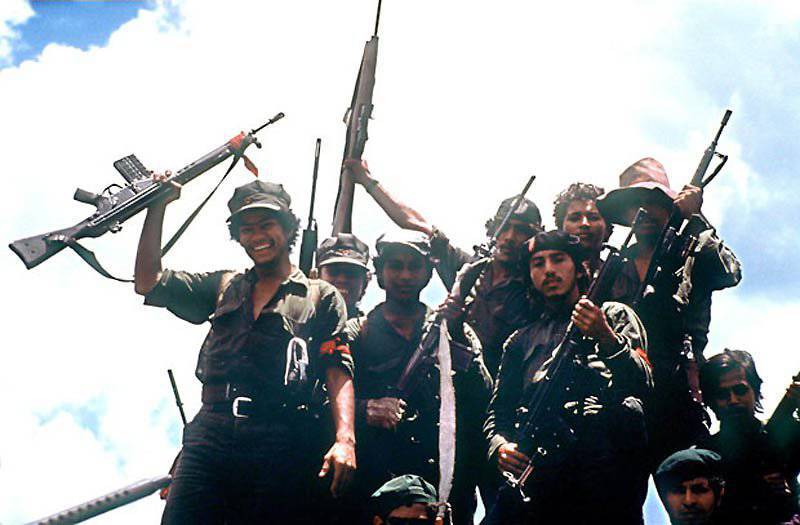
Thus, the Sandinista revolution won, becoming the second, after the Cuban revolution, an example of the successful arrival of anti-imperialist forces to power in a Latin American country in a revolutionary way. In the United States of America, the victory of the Sandinista revolution in Nicaragua was perceived as a terrible geopolitical defeat, comparable to the Cuban revolution.
It should be noted that for seventeen years of fierce guerrilla warfare, which from 1962 to 1979. Sandinistas waged against the Somoza regime, more than 50 thousands of Nicaraguans died, hundreds of thousands lost their homes over their heads, more than 150 thousands of people were forced to leave Nicaragua. Many hundreds of representatives of the Nicaraguan intelligentsia, thousands of ordinary people were tortured in the prisons of the pro-American regime, or “went missing”, in fact, after being killed by special services or pro-government armed formations of punitive.
But even after the victory, the Sandinistas faced a serious problem in the face of the resistance of the "contras" - armed mercenary detachments, trained and sponsored by the United States of America and made raids into Nicaraguan territory from neighboring Honduras and Costa Rica, where pro-American governments remained. Only by the 1990 years did the Contras gradually cease their terrorist activities, which was connected, first of all, with the end of the Cold War and, as it seemed to American leaders, the inevitable and imminent end of left-wing ideas in Latin America (what we see from the analysis of the history of Latin American states in the 1990-2010-s, did not happen).
Thus, in fact, it is the United States that is fully responsible for the long-term civil war in Nicaragua, the country's socioeconomic problems, ravaged by the consequences of the war, the thousands of victims of the dictatorial regime. From the first years of post-revolutionary existence, the Sandinista government set about improving the socio-economic situation in the country, first of all, solving the problems of medical care, increasing the social protection of the population, giving Nicaraguans the right to receive education, including eliminating the illiteracy of the general population.
Nicaragua, Ortega and Russia
Understanding the true role of the United States in its history, Nicaraguans are not distinguished by the idealization of the American state. In recent years, Nicaragua, along with Venezuela, has been acting as Russia's unconditional ally in Latin America. In particular, Nicaragua among the few countries of the world officially recognized the independence of South Ossetia and Abkhazia, for which Daniel Ortega was awarded the highest awards of these states. And the matter here is most likely not only in the importance of the economic ties of this Latin American country with the Russian Federation, but also in the anti-imperialist positions of President Ortega.
Daniel Ortega is one of the few current leaders of the world who emerged from the heroic era of wars and revolutions. He was born in 1945 year, and began to engage in revolutionary activities from the age of fifteen, when he was arrested for the first time. During the pre-revolutionary period of his life, Ortega managed to make war and go to prisons, becoming one of the first leaders of the Sandinista National Liberation Front.
At 21, he was already the commander of the Central Front of the Sandinista National Liberation Front, then spent eight years in prison and was released in exchange for the Americans taken hostage by his comrades. From the first days of the revolution, he was among its key leaders, and later headed the government.
However, in the 1990 year, Daniel Ortega was re-elected as president of the country and re-occupied him only in the 2001 year, after the general election of the president. That is, even experts in the information war from the American mass media cannot blame this professional revolutionary in the absence of a democratic principle.
Thus, the positive significance of the 1979 Sandinista revolution of the year is also evident for modern Russia. First, thanks to the Sandinista revolution, our country has found another small but valuable ally in Latin America, near the United States. Secondly, it has become an excellent example of how courage and perseverance help the "forces of good" to crush the dictatorship, despite all its national guardsmen and multimillion-dollar assistance from the United States. Finally, Nicaragua is counting on the help of Russia and China in the construction of the Nicaraguan Canal - the very one that the Americans were trying to prevent by any means at the beginning of the 20th century, even going on for many years of military occupation of Nicaragua.
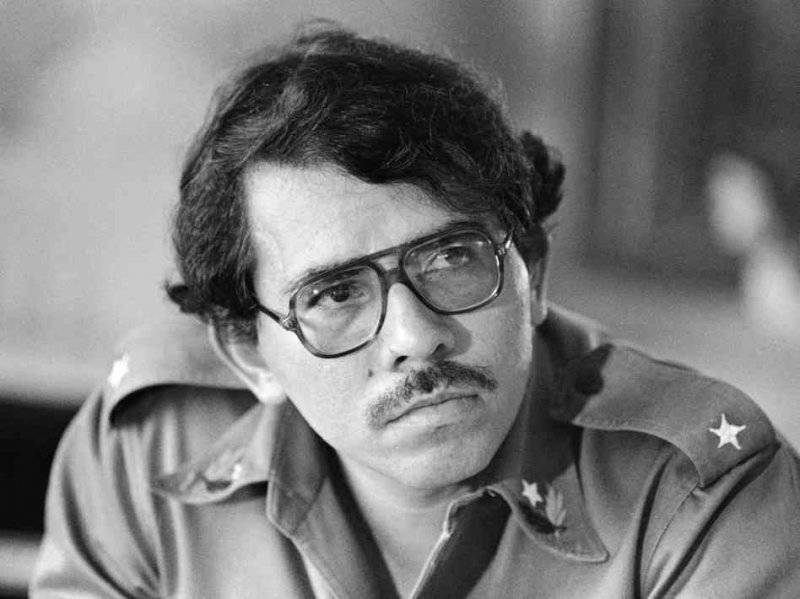
Information